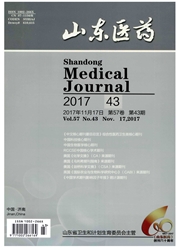

 中文摘要:
中文摘要:
目的:研究聚氰基丙烯酸丁酯纳米粒( polybutylcyanoacrylate nanoparticles, PBCA-NPs, NPs )介导的端粒酶逆转录酶(human telomerase reverse transeriptase, hTERT)基因反义寡核苷酸 (antisense oligodeoxynucleotide, ASODN)对食管癌细胞EC9706生物活性的影响。方法:采用乳化聚合法制备聚氰基丙烯酸丁酯纳米粒作为转染寡核苷酸(SODN)的载体,利用激光粒度分析仪和原子力显微镜测定制备NPs的粒径及zeta电位;以NPs介旱8条不同hTERT ASODN(NPs—ASODNⅠ、NPs—ASODNⅡ、NPs—ASODN Ⅲ、NPs—ASODNⅣ、NPs—ASODNⅤ、NPs—ASODNⅥ、NPs—ASODNⅦ和NPs—ASODNⅧ)转染食管癌细胞EC9706,采用MTT法检测转染后对EC9706细胞增殖的影响;采用RT-PCR检测hTERT mRNA表达情况;流式细胞术检测细胞凋亡率。结果:所制NPs粒径均匀、zeta电位较高,较为理想;以NPs介导hTERT ASODN转染24h时,EC9706细胞增殖被明显抑制,该抑制作用随转染时间的延长和浓度的增高依次增强,与细胞对照组相比有显著差异(P〈0.05);且不同ASODN转染后对EC9706细胞抑制率不同。单纯NPs组、正义寡核苷酸NPs—SODN组和单纯ASODN组转染后对EC9706细胞增殖无明显抑制作用(P〉0.05)。NPs—ASODN转染EC9706细胞72h时,hTERT mRNA表达水平明显降低,与细胞对照组相比有显著差异(P〈0.05)。NPs—ASODN转染72h时,NPs—ASODNⅠ、Ⅴ、Ⅵ、Ⅶ、Ⅷ转染组EC9706细胞出现明显凋亡现象(P〈0.05),而NPs—ASODNⅡ、Ⅲ、Ⅳ转染组EC9706细胞未发生明显的凋亡现象(P〉0.05)。结论:聚氰基丙烯酸丁酯纳米粒可以作为一种良好的基因载体,在其介导下hTERT ASODN能有效抑制食管癌细胞EC9706的增殖和hTERT mRNA的表达,并能诱导细胞凋亡。提示该纳米粒作为一种新型纳米载体为食管癌的基因治疗提供了一条新的途径。这种抑制作用具有时间和浓度依赖性,并具有序?
 英文摘要:
英文摘要:
Objective: To investigate the effects of antisense oligodeoxynucleotide (ASODN) for hTERT mediated by nanoparticles on esophageal carcinoma cells EC9706 in vitro. Methods: As an oligodeoxynucleotide carrier, the polybutylcyanoacrylate nanoparticle was prepared by emulsion polymerization method. The diameter and zeta potential were measured by atom force microscopy (AFM) and Nanosize machine, respectively. The eight different ASODNs (NPs-ASODNⅠ, NPs-ASODNⅡ, NPs-ASODNⅢ,NPs-ASODN Ⅳ, NPs-ASODN Ⅴ, NPs-ASODN Ⅵ, NPs-ASODN Ⅶ NPs-ASODN Ⅷ) for hTERT were transfected into EC9706 cells by polybutylcyanoacrylate nanoparticles (NPs). The MTT assay was used to detect the proliferation of EC9706 cells. The level of hTERT mRNA expression was measured by IRT-PCR. Apoptosis was detected by flow cytometry (FCM). Results: NPs with even size and smooth surface were successfully obtained. The inhibitory effects of different NPs-ASODNs on the proliferation of EC9706 cells after transfection were time- and concen- tration-dependent. Significant differences were found in the inhibitory rates between NPs-ASODN transfected cells and the control cells (P〈0.05). However, no significant inhibitory effect was observed in cells transfected with NPs, SODN or ASODN. At 72 hours after transfection, the level of hTERT mRNA in EC9706 cells was lower than that in the control cells (P〈0.05). EC9706 cell apoptosis was seen in NPs-ASODN Ⅰ, Ⅴ, Ⅵ, Ⅶ, and Ⅷ groups at 72 hour after transfection. No obvious apoptosis was found in the NPs-ASODN Ⅱ, Ⅲ, and Ⅳgroups (P〉0.05). Conclusion: NPs can be used as good gene carriers. ASODNs for hTERT mRNA mediated by NPs can effectively inhibit the proliferation of EC9706 cells, decrease the level of hTERT mRNA, and induce EC9706 cell apoptosis in vitro, indicating that NPs may be used in targeted cancer therapy. The inhibitory effects are concentration-dependent, time-dependent, and sequence specific, indicating that different hTERT gene point
 同期刊论文项目
同期刊论文项目
 同项目期刊论文
同项目期刊论文
 期刊信息
期刊信息
